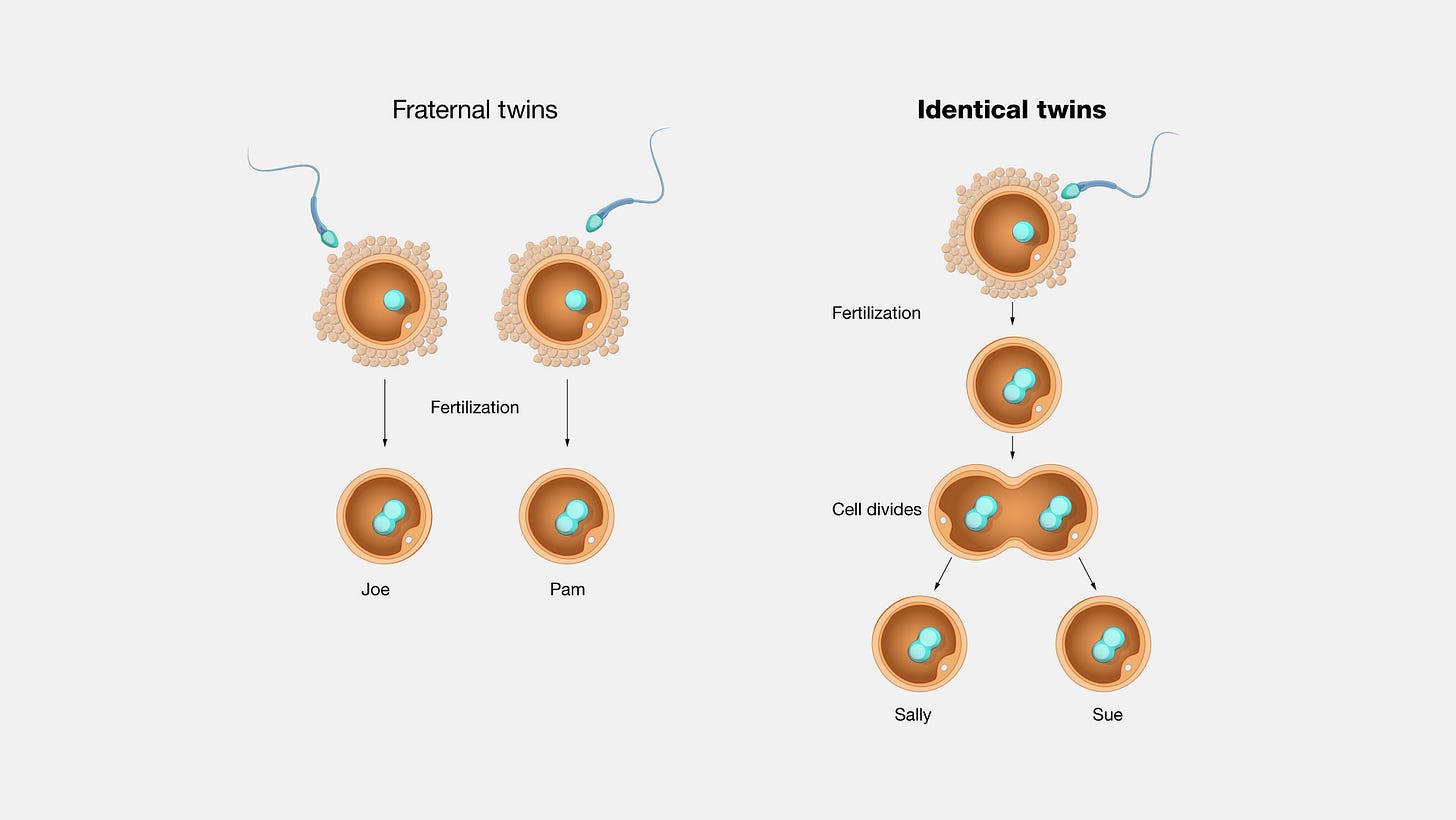I figured I should start this blog on a basic twin glossary since not everyone had an amazing 8th grade science teacher or did a deep dive on Google at 1:00 am. What you’ll find below is a list of the quirky variations twins can be classified as and how those come to be. I won’t say this is exhaustive because I kept uncovering ones I didn’t know about!
Are You Guys Twins?
Google defines a twin as “one of two children or animals born at the same birth.” In other words, the most basic criteria of being a twin is sharing a birthday.
It surprised me that this definition included animals too, but of course twinship isn’t exclusive to humans. If you think about every species that has a litter or more than one offspring (which is a lot of species), that’s a set of twins. That’s pretty crazy!
Identical vs Fraternal Twins
How twins occur and whether they’re identical or fraternal is all in the conception. Bear with me through this section about fertilization. I’ll make it a chart to make it more tolerable.
Identical
AKA monozygotic twins
Twins share the same genomes (causing identicality)
A single sperm fertilizes a single egg which then splits in two
Identical twins are the same sex (except for extremely rare cases)
Fraternal
AKA dizygotic or non-identical twins
Twins share half of the same genomes (causing similar appearance)
Two sperm fertilize two separate eggs
Fraternal twins can be any combination of sexes
When someone is having twins, 2/3rds of the time, it’s a fraternal set. I myself am an identical twin which means my twin and I beat the odds!
Triplets, Quadruplets, Quintuplets, And So On
Multiples are the result of the fertilization process mentioned above repeated more than once. A consequence of this means that sets of multiples can be made up of fraternal and identical twins. For example, consider a set of fraternal eggs. One of those eggs splits in two. This results in identical twins with a fraternal twin and, all together, triplets. This repetition is what makes having identical multiples so rare — a single starting egg has to split multiple times.
Conjoined Twins
Conjoined twins are a subset of identical twins where the twins’ bodies are attached. This is a result of the egg not entirely splitting or re-fusing together. Conjoined twin births are especially difficult and unfortunately these twins have a very low chance of survival due to this and the sharing of vital organs.
Mirror Twins
Also a subset of identical twins, mirror twins are twins whose bodies are reflections of each other. For example, one twin may have a birthmark on their left arm and the other twin has a birthmark on their right arm. This can even influence the twins’ dominant hands. Why mirror twins occur have to do with timing – if both “sides” of a single egg are developed before the split, then you have mirror twins.
Superfetation
Superfetation is when another egg is released while a person is already pregnant. If this second egg is fertilized, it can result in a fraternal twin that is a different age than the other baby. Additionally, this second egg could be fertilized by a different sperm, meaning the twins could have two separate fathers. This is a common occurrence with animals, but I honestly wonder if it’s just rare with people because of our largely monogamous society.1
Vanishing Twin Syndrome
I’m always amused to meet people who proudly say they “ate their twin in the womb.” My sister jokes that she’s never surprised when someone reveals this information, “People who eat their twin in the womb just have this energy about them.” It is a bit grim to laugh about though. Vanishing twin syndrome is a miscarriage – one twin embryo stops developing and gets absorbed by the mother and remaining twin.
I’ve included it in this glossary because it’s something I’ve been curious about. Do people who lost their twin in the womb consider themselves a twin? By the Google definition mentioned above, they technically aren’t a twin since they weren’t both born. But also, fuck Google definitions. Even if it’s not as full of a twin experience, it’s still a loss to both the surviving twin and the parent(s). Living with the hypotheticals can be haunting. On the other hand, the remaining twin also grows up not knowing any different.
Polar Body Twins
Scientists have theorized that there could be a third type of twin in addition to fraternal and identical twins called polar body twins. Basically, the steps of twin conception get a bit mixed up. The egg splits before fertilization and the smaller of the eggs is the polar body. This polar body usually isn’t robust enough to survive and there have been no confirmed cases because of this, but it theoretically is a possibility. While identical twins share all of their DNA and fraternal twins share half, polar body twins would share 3/4s of their DNA.
So, there you have it! A whole lot about different kinds of twins that you either already knew about, but hopefully a fair amount of new information, too. There’s a lot of biological nuances with twins and hopefully this clarified those key differences.
It’s my goal to find media that features all of these different kinds of twins. I’ll collect them like Pokémon. This probably makes polar body twins the legendary Pokémon.
Does anyone want to volunteer on being a test subject for this theory?






